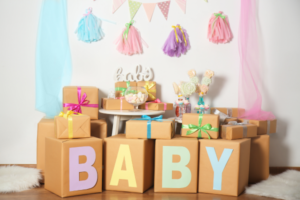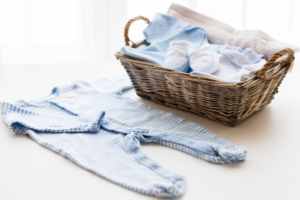Becoming a new mom brings a whirlwind of excitement, love, and challenges. One of the many things you’ll find yourself doing is selecting clothing for your baby. While it might seem like a straightforward task, dressing your baby for comfort and style requires careful consideration. Babies are delicate, and their clothing needs to meet the demands of their sensitive skin, temperature regulation, and practicality, while still reflecting your unique sense of style.
This guide will walk you through how to dress your little one in a way that ensures they’re comfortable and stylish from day one.
Understanding Fabric Choices for Baby Clothes
When dressing your baby, comfort is key, and the first thing to consider is the fabric. Babies have sensitive skin that can be prone to irritation or rashes, so selecting the right materials is crucial.
Natural Fabrics: Organic cotton, bamboo, and muslin are some of the best materials for baby clothing. These fabrics are soft, breathable, and gentle on the skin, reducing the risk of irritation. Cotton is especially popular because it’s lightweight, durable, and easy to clean.
Avoid Synthetic Fabrics: While synthetic materials like polyester or nylon might look stylish, they can cause discomfort. These fabrics don’t allow the skin to breathe, leading to overheating or sweating, which can be uncomfortable for a baby. Stick to natural, hypoallergenic fabrics whenever possible.
Check for Certification: Look for clothes labeled as “Oeko-Tex certified” or “GOTS certified,” which means the materials have been tested for harmful chemicals and are safe for baby skin.
Layering for Comfort
One of the essential strategies for dressing your baby, especially as seasons change, is learning the art of layering. Babies, especially newborns, have difficulty regulating their body temperature, so it’s up to parents to dress them appropriately for the weather.
The Rule of One More Layer: A general rule of thumb is to dress your baby in one more layer than you would wear. For example, if you’re comfortable in a t-shirt, your baby might need a t-shirt and a light cardigan or onesie to stay warm.
Easy-to-Remove Layers: Layers should be easy to remove in case your baby becomes too warm. Opt for cardigans, vests, and jackets with easy fastenings so you can quickly adjust their clothing.
Consider Season and Climate: In cooler weather, you can layer your baby in long-sleeved onesies, soft leggings, and a warm outer layer like a fleece jacket. In warmer months, lightweight cotton rompers and short-sleeved onesies may be all your baby needs.
Choosing the Right Size for Your Baby
Babies grow fast, so it’s easy to accumulate clothing that they outgrow quickly. However, it’s important to choose the right size for their current stage of development to ensure comfort and mobility.
Don’t Buy Too Far Ahead: While it’s tempting to buy clothes in bigger sizes to get more wear out of them, overly large clothes can be uncomfortable and impractical. Clothing that’s too big can bunch up, restrict movement, and even pose a choking hazard if it rides up.
Stick to Essentials: Babies don’t need an extensive wardrobe. Stick to a selection of basics like onesies, sleepers, and leggings that can be easily mixed and matched. This will not only simplify dressing but also minimize waste when your baby outgrows their clothing.
Pay Attention to Fit: Ensure the clothes fit snugly around your baby’s neck, wrists, and ankles without being tight. Loose clothing can get tangled or bunched, while tight clothing can be restrictive and uncomfortable.
Comfort Above All
Comfort should always be a priority when dressing your baby. While stylish clothes are fun to shop for, it’s essential to remember that babies spend most of their time sleeping, playing, or feeding. As a result, their clothing needs to be soft, flexible, and breathable.
Opt for Clothes with Soft Seams: Check that clothing has smooth seams that won’t rub or chafe your baby’s sensitive skin. Avoid clothes with tags inside, as these can irritate delicate skin.
Pick Stretchy Fabrics: Babies move a lot, even from a very young age. Fabrics that stretch allow for more freedom of movement, making it easier for your baby to kick their legs or roll over without restriction.
Prioritize Simple Fastenings: Clothes with too many buttons or zippers can make diaper changes difficult. Look for onesies with snap closures or stretchy necklines for easy dressing and undressing.
Dressing for Different Occasions
As a new mom, you’ll want to ensure your baby is dressed appropriately for different occasions, whether it’s a casual day at home, a family outing, or a special event. Balancing comfort and style doesn’t have to be complicated.
Casual Days at Home: For everyday wear, comfort is key. Opt for soft onesies, rompers, or sleepers made from breathable materials like cotton. These allow your baby to move freely while keeping them cozy and comfortable.
Outings and Special Events: When you’re heading out or attending a special occasion, you can dress your baby in something a little more stylish. Think of baby dresses, button-up shirts, or cute rompers. However, don’t sacrifice comfort for style. Ensure that even dressy clothes are made from soft fabrics and don’t have any embellishments that could irritate the skin.
Seasonal Clothing: In the summer, light cotton onesies, sun hats, and breathable shoes or sandals are essential. In the winter, consider layering with soft sweaters, baby mittens, and cozy booties to keep your baby warm without overheating.
Footwear and Accessories
Footwear and accessories might not be necessary for a newborn, but as your baby grows, these items can serve both functional and aesthetic purposes.
Socks and Booties: During the early months, your baby won’t need shoes, but keeping their feet warm is essential. Soft socks or booties are great options. Choose ones that aren’t too tight around the ankles but stay on securely.
Hats for Sun Protection and Warmth: In colder months, a soft hat helps your baby retain heat, while in warmer weather, a lightweight hat with a brim can shield their sensitive skin from the sun.
Avoid Over-Accessorizing: While bows, headbands, and hats can be adorable, make sure they don’t interfere with your baby’s comfort. Avoid tight or bulky accessories that could cause discomfort or pose a safety hazard.
Practicality Meets Style
While comfort should always come first, there’s no reason why your baby can’t be stylish, too! The baby clothing industry has come a long way, offering a wide range of adorable outfits in various colors, patterns, and designs that reflect the latest trends.
Mix and Match Basics: Create a capsule wardrobe for your baby by selecting neutral basics that can easily be paired with more colorful or patterned items. A simple white onesie can be paired with brightly colored leggings or a fun printed jacket.
Patterns and Colors: Don’t shy away from vibrant colors and playful patterns! Babies look great in bright shades, fun prints, and whimsical designs. Just make sure the fabric is soft and breathable.
Consider Your Baby’s Personality: Some babies are more sensitive to tight clothing or prefer softer textures. Pay attention to how your baby reacts to different fabrics, and choose clothing that reflects their personality and comfort preferences.
Final Thoughts
Dressing your baby for comfort and style doesn’t have to be complicated. By focusing on high-quality, breathable fabrics, the right size, and practical layering, you can ensure your baby is comfortable, happy, and stylish in any situation. Remember that while it’s fun to dress your little one in cute outfits, comfort should always come first. With the tips in this guide, you’ll be ready to dress your baby in a way that combines practicality with your unique sense of style, creating a wardrobe that both you and your baby will love.









